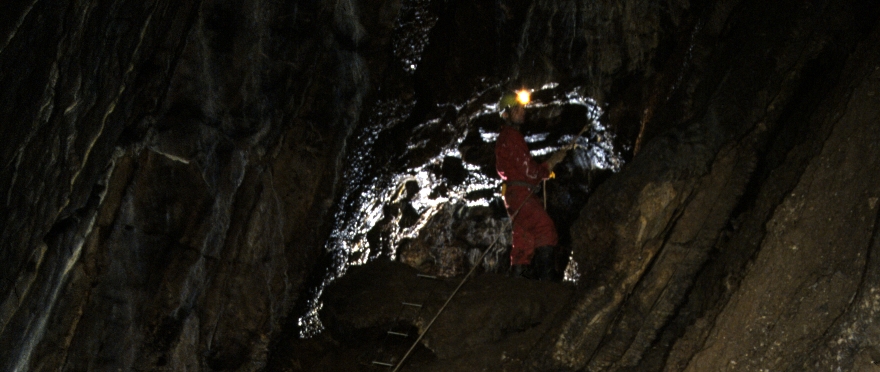The Earliest Cave Survey
This cave has been mapped four times, in detail. The earliest survey was carried by Captain Greenville Collins of the Survey yatcht “Merlin”. Captain Collins was involved in carrying out a seven year survey of the coastal waters around Britain, which was published in 1693 as “Great Britain’s Coastal Pilot” (J.K.L. 1968). In September 1682, Captain Collins was visiting Sir Robert Southwell, who persuaded him to undertake an exploration and survey of the cave. This was carried out by him and his crew on the 18th and 19th September 1682 and Sir Robert was responsible for the publication of a plan of the chamber and a section of the whole cave in the Philosophical Transactions of the Royal Society in January 1683 (Southwell, 1683). Although the section is recognisable as being this cave, the whole is inaccurate in detail. The given depth of the cave, to twenty yards above high tide in the Severn, is consistent with modern estimates. This is, as far as is known, the earliest publication of a cave survey in the world (Shaw, 1979).
Mr White’s Survey
Considerable local interest in the site was aroused by the unfortunate death of Rev. Newham in 1775. One of the many subsequent explorers was a local land surveyor called William White who made several descents between March 1775 and the Autumn of 1776. He worked sometimes alone and sometimes with the assistance of George Symes Catcott, brother of the early geologist, Alexander. Manuscript copies of his east-west and north-south sections of the cave as well as his surface plan may be found in the Bristol Reference Library (manuscript B10158). The two sections were published by Rudder (1779). The published sections are faithful in terms of dimensions but have lost some of the detail recorded on the manuscript and hand-drawn copies, notably two rock pillars shown as being visible in low water and probably corresponding to the two stones shown by Collins. Later publications based on White’s work, especially by Catcott (1792 and 1842) appear to be a combination of these two sections and are much less accurately drawn.
Facsimile of Mr White’s survey.
The Cave Research Group
After the cave’s rediscovery and reopening in 1957, an up to date survey was carried out by members of the Cave Research Group which was eventually published in 1963 (Tratman, 1963). This survey formed the basis of the later publication by Mullan (1993) which corrected minor drafting errors in the 1963 edition and added information on Upper East Passage and the Lake which were now fully explored for the first time. In 2006 this survey was slightly modified, again, when it was corrected using radiolocation equipment to fix the surface location of a point on the west ledge (Farrant and Mullan, 2008).
The 1993 edition of the cave survey.
Laser surveying
Although the 1950’s survey has enabled the production of a good accurate plan and elevations of the cave, especially after the 2006 radiolocation exercise, modern cave survey techniques have enabled us to better those results and even to produce movable 3d models of the cave showing it ‘in the round’ and in relation to the land surface above. This is useful, for example, for demonstrating just how close the upper parts do get to the land surface. This work is still ongoing, not least because much of the lower part of the cave has been under water and therefore inaccessible since the work was started. Conditions have, however, allowed us to now map nearly all of the cave. Plans are in hand to complete the underwater part of the survey in the near future. All of these are released under a Creative Commons Licence, but please note the inclusion of OS copyright mapping data in one model.
The 2015 edition of the cave survey, showing all but the permanently flooded parts of the cave.
A “Survex” 3d model of the upper parts of the cave.
Viewing this model requires Survex to be installed on your computer.
A “Therion” 3d model of the upper parts of the cave.
Contains Ordnance Survey data © Crown copyright and database right 2010.
Viewing this model requires Therion to be installed on your computer.
